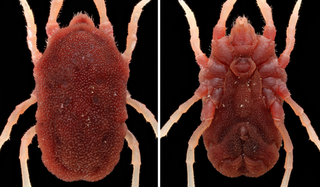
Ticks are parasitic arachnids that are part of the superorder Parasitiformes. Along with mites, they constitute the subclass Acari. Adult ticks are approximately 3 to 5 mm in length depending on age, sex, species, and "fullness". Ticks are external parasites, living by feeding on the blood of mammals, birds, and sometimes reptiles and amphibians. It is estimated ticks originated during the Late Cretaceous period, approximately 120 MYA, the earliest tick fossil in New Jersey amber is dated at 90-94 million years old. Ticks are widely distributed around the world, especially in warm, humid climates.

The Argasidae are the family of soft ticks, one of the three families of ticks. The family contains 193 species, although the composition of the genera is less certain, and more study is needed before the genera can become stable. The currently accepted genera are Antricola, Argas, Nothoaspis, Ornithodoros, and Otobius. The Argasidae are very common in South Asia, along with 96 other species of ticks, making South Asia the region with the highest biodiversity of ticks worldwide. Soft ticks are resistant to desiccation and can live for several years in arid conditions.

The coxal gland is a gland found in some arthropods, for collecting and excreting urine. They are found in all arachnids, and in other chelicerates, such as horseshoe crabs. The coxal gland is thought to be homologous with the antennal gland of crustaceans. The gland consists of an end sac (saccule), a long duct (labyrinth) and a terminal bladder (reservoir). There is generally only one pair, and they open on the coxae of the walking legs. The coxal secretion of adult female ticks of Ornithodoros erraticus contains a sex pheromone.
Alkhurma virus (ALKV) is a zoonotic virus of the Flaviviridae virus family. ALKV causes Alkhurma hemorrhagic fever and is mainly based in Saudi Arabia.
Relapsing fever is a vector-borne disease caused by infection with certain bacteria in the genus Borrelia, which is transmitted through the bites of lice or soft-bodied ticks.

Borrelia hermsii is a spirochete bacterium that has been implicated as a cause of tick-borne relapsing fever. It is spread by the soft-bodied tick Ornithodoros hermsi.
Carios erraticus, formerly called Ornithodoros erraticus, is a species of tick in the family Argasidae. The tick was described by Hippolyte Lucas in 1849.

Ornithodoros is a genus in the soft-bodied tick family, Argasidae.

Ornithodoros hermsi is a species of soft tick. It can be infected with Borrelia hermsii.
Borrelia duttoni, formerly known as Spirochaeta duttoni, is a species of Borrelia.

Ornithodoros moubata, commonly known as the African hut tampan or the eyeless tampan, is a species of tick in the family Argasidae. It is an ectoparasite and vector of relapsing fever in humans, and African swine fever in pigs.

Ornithodoros turicata, commonly referred to as the relapsing fever tick, is a soft tick found in the midwestern and southwestern United States. It is a known vector of Borrelia turicatae, a spirochete responsible for tick-borne relapsing fever in humans. Additionally, vector competence for the transmission of Leptospira pomona, the agent of canine jaundice, has been demonstrated in a laboratory setting.
Borrelia coriaceae is a species of spirochete bacteria and member of the genus Borrelia. Strains of this species have been isolated from the soft tick Ornithodoros coriaceus and from mule deer.

Nyamiviridae is a family of negative-strand RNA viruses in the order Mononegavirales. Ecdysozoa and birds serve as natural hosts. The name is a portmanteau of Nyamanini Pan and Midway Atoll and the suffix -viridae used to denote a virus family. There are currently twelve species in this family divided among six genera.

Ornithodoros savignyi, known as sand tampan, African eyed tampan or Kalahari sand tampan, is one of some 37 species in the genus Ornithodoros and is a soft tick with a leathery, mammillated integument, causing paralysis and tampan toxicosis, two unrelated conditions. The sand tampan is an ectoparasite on humans, their livestock and wild animals, including birds and bats. Occurring in semi-desert areas of Africa, Saudi Arabia and other parts of the Persian Gulf, India, Sri Lanka and into Asia, it is able to survive for lengthy periods without feeding, spending most of its life burrowed under sand or loose soil, often in wait for animals that rest or sleep under trees or in the lee of rocks, but also in places where people or their animals congregate such as marketplaces, places of worship, cattle kraals and village squares. The timing of its activity is geared to coincide with that of potential hosts, but hot sunny conditions are usually avoided. Because of its habit of feeding and dropping from its host, adult dispersal is limited, whereas larvae may remain attached to their hosts for several days. During its life cycle it will feed on multiple hosts between moults.
Royal Farm virus, previously known as Karshi virus, was not viewed as pathogenic or harmful to humans. Although infected people suffer with fever-like symptoms, some people in Uzbekistan have reported with severe disease such as encephalitis and other large outbreaks of fever illness connected infection with the virus.
Ornithodoros madagascariensis is a "soft tick" that parasitizes cave-inhabiting fruit bats in the genus Megachiroptera. First circumscribed in 1962 by Harry Hoogstraal, it is classified in the subgenus Reticulinasus.
The Artashat orthonairovirus (ARTSV), is a species in the genus Orthonairovirus, first isolated from Ornithodoros alactagalis, belonging to the soft tick family Argasidae in Armenia in 1972.
Ornithodoros brasiliensis is a species of tick in the family Argasidae, or soft-bodied ticks, that occurs exclusively in Rio Grande do Sul, Brazil. O. brasiliensis is a known parasite of humans, dogs, and smaller mammals such as armadillos and skunks.








